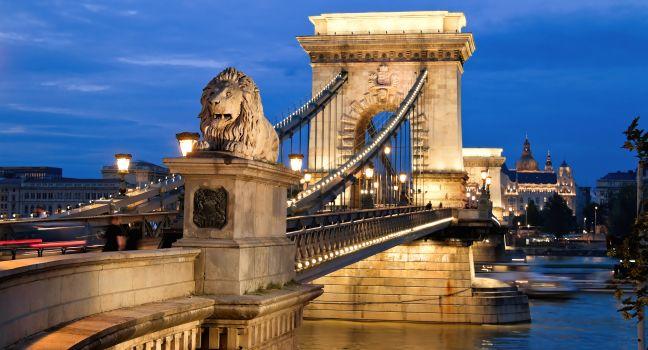Fodor's Expert Review Széchenyi Lánchíd

The oldest and most elegant of the eight road bridges that span the Danube in Budapest—particularly when lit up at night—the Széchenyi Chain Bridge connects Víziváros on the west bank with Lipótváros on the east. Before it was built, the river could be crossed only by ferry or by pontoon bridge that had to be removed when ice blocks began floating downstream in winter. It was constructed at the initiative of the great Hungarian reformer and philanthropist Count István Széchenyi, using an 1839 design by the English civil engineer William Tierney Clark, and was finished by the Scotsman Adam Clark (no relation). After it was destroyed by the Nazis, the bridge was rebuilt in its original, classical and symmetrical form—though widened for traffic—and was reopened in 1949, on the centenary of its inauguration. At the Buda end of the Chain Bridge is Clark Ádám tér (Adam Clark Square), from which you can zip up to Castle Hill on the sikló (funicular); it's 1,400 HUF... READ MORE
The oldest and most elegant of the eight road bridges that span the Danube in Budapest—particularly when lit up at night—the Széchenyi Chain Bridge connects Víziváros on the west bank with Lipótváros on the east. Before it was built, the river could be crossed only by ferry or by pontoon bridge that had to be removed when ice blocks began floating downstream in winter. It was constructed at the initiative of the great Hungarian reformer and philanthropist Count István Széchenyi, using an 1839 design by the English civil engineer William Tierney Clark, and was finished by the Scotsman Adam Clark (no relation). After it was destroyed by the Nazis, the bridge was rebuilt in its original, classical and symmetrical form—though widened for traffic—and was reopened in 1949, on the centenary of its inauguration. At the Buda end of the Chain Bridge is Clark Ádám tér (Adam Clark Square), from which you can zip up to Castle Hill on the sikló (funicular); it's 1,400 HUF one way. The square is also home to the 0 kilométerkő (Zero Kilometer Stone), a sculpture from which all highway distance signs are measured all over the country.
READ LESS








